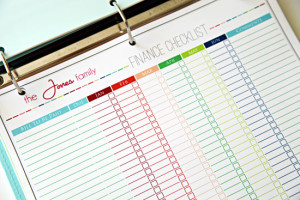 By: Gail Vaz Oxlade
By: Gail Vaz Oxlade
Set-Up
-
Gather all your paperwork.
Create a file folder for each of the following:• Chequing accounts
• Savings accounts
• Retirement accounts
• Investment accounts
• Credit card accounts
• Loans
• Personal lines of credit
• Mortgage
• Insurance: life, disability, health, critical illness, home, car
• Estate: wills & powers of attorney
• Tax returns -
Welcome to 21st Century banking
If you don’t already have it, set up telephone or internet banking for your accounts. -
Reduce fees by setting up a buffer
If you can afford it, transfer $1,000 float to your chequing account (pretend it isn’t there) and use that to minimize your banking costs. -
Save automatically
Create an auto-debit from your chequing account to a savings account that will not be touched. Most people won’t put money into a savings account on a regular basis, opting to wait for a tax-refund or bonus before setting aside some money for the future. Establish an automatic savings deposit every month and your nestegg will accumulate faster than you think. -
Create a Monthly Bill Summary
List your bills in the date order they need to be paid to prevent you from missing a bill. If you have bills that are paid automatically from your account, write an “A” beside these bills and remember to deduct them from your Spending Journal at bill payment time each month. -
Set-up your in-baskets
Create an in-basket with two Bills folders labeled “1-15” and “16-31”
When a bill comes in, look at the due date and put the bill it in the appropriate folder. Recycle all the marketing crap in the envelope.
Create a second in-basket with 3 folders labeled “bank statements”, “bills paid” and “tax receipts”.Weekly -
Make a date with your money
On the 12th and 28th of each month to pay bills, set aside the time in your schedule – you’ll need about 30 minutes, depending on your bills — to pay your bills.Always pay your bills in one place that you’ve equipped with your bill paying system, spending journal, envelopes, stamps, pens, pencils, a calculator, tape, a stapler and return address labels and recycling bin for all that marketing stuff you’re going to dump.When you pay a bill, write the cheque or transaction number, amount paid, and the date you paid it on the bill. Put the paid bill in your “bill’s paid” file. Deduct the amount you’ve spent from your Spending Journal. If a bill has not been paid in full (tax bills are paid over several months, for example) put it back in your Bills Folder so you don’t forget it.
Monthly
-
Reconcile you bank statements
When you bank statements come in, put them in your in-box folder. Make a date when all your statements are in (it’ll depend on when you receive them) to:1. review your statements to make sure there are no mistakes
2. reconcile your Spending Register; clearly mark the cheques that have been returned to you and highlight the ones in your Spending Register that haven’t yet cleared the bank. A cheque that is taking a long time clearing the bank can lull you into thinking you have more money than you do. Go back at least a month to make sure all previous check have cleared.
3. talk about anything unusualQuarterly
-
File
Once a quarter, file all your paperwork to keep your system current. -
Talk
Have a dinner with your business partner and talk about the bumps, your goals and how you’re doing. Annually -
Re-vamp your budget
Review your budget using last years cc statements and bank statements to see what you actually spent. If you spent more on a particular category, make sure you know why, or look for ways to trim. -
Clean up
Go through your files at the end of each year and throw out bills and receipts no longer needed for auditing/budgeting purposes.
Sourced from: http://www.gailvazoxlade.com/resources/12steps_getting_organized_financially.html
